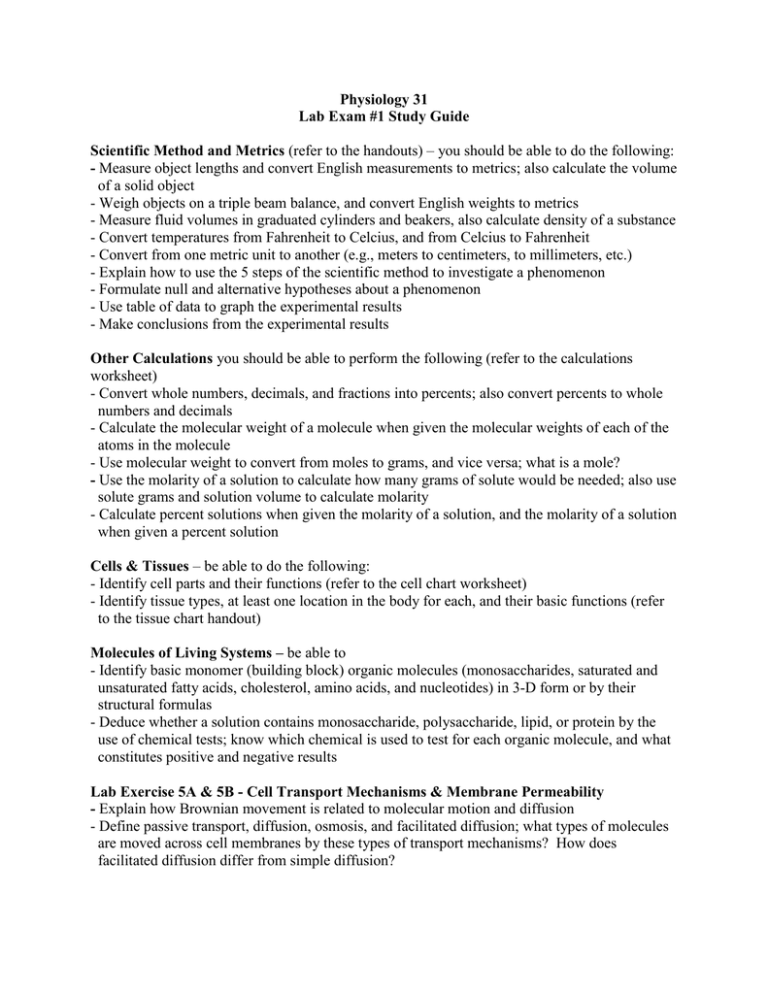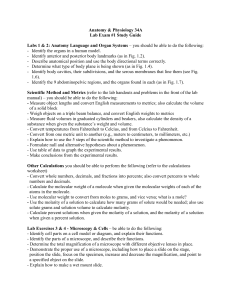- Lab Exam 1 Study Guide
advertisement

Physiology 31 Lab Exam #1 Study Guide Scientific Method and Metrics (refer to the handouts) – you should be able to do the following: - Measure object lengths and convert English measurements to metrics; also calculate the volume of a solid object - Weigh objects on a triple beam balance, and convert English weights to metrics - Measure fluid volumes in graduated cylinders and beakers, also calculate density of a substance - Convert temperatures from Fahrenheit to Celcius, and from Celcius to Fahrenheit - Convert from one metric unit to another (e.g., meters to centimeters, to millimeters, etc.) - Explain how to use the 5 steps of the scientific method to investigate a phenomenon - Formulate null and alternative hypotheses about a phenomenon - Use table of data to graph the experimental results - Make conclusions from the experimental results Other Calculations you should be able to perform the following (refer to the calculations worksheet) - Convert whole numbers, decimals, and fractions into percents; also convert percents to whole numbers and decimals - Calculate the molecular weight of a molecule when given the molecular weights of each of the atoms in the molecule - Use molecular weight to convert from moles to grams, and vice versa; what is a mole? - Use the molarity of a solution to calculate how many grams of solute would be needed; also use solute grams and solution volume to calculate molarity - Calculate percent solutions when given the molarity of a solution, and the molarity of a solution when given a percent solution Cells & Tissues – be able to do the following: - Identify cell parts and their functions (refer to the cell chart worksheet) - Identify tissue types, at least one location in the body for each, and their basic functions (refer to the tissue chart handout) Molecules of Living Systems – be able to - Identify basic monomer (building block) organic molecules (monosaccharides, saturated and unsaturated fatty acids, cholesterol, amino acids, and nucleotides) in 3-D form or by their structural formulas - Deduce whether a solution contains monosaccharide, polysaccharide, lipid, or protein by the use of chemical tests; know which chemical is used to test for each organic molecule, and what constitutes positive and negative results Lab Exercise 5A & 5B - Cell Transport Mechanisms & Membrane Permeability - Explain how Brownian movement is related to molecular motion and diffusion - Define passive transport, diffusion, osmosis, and facilitated diffusion; what types of molecules are moved across cell membranes by these types of transport mechanisms? How does facilitated diffusion differ from simple diffusion? - Define active transport. How does active transport differ from passive transport? What is the most common form of active transport in the body? - Describe filtration. Name one area in the body where filtration takes place. - Define osmotic pressure and hydrostatic pressure. How are they related? - What six factors influence the rate of diffusion, and how do they affect diffusion? - Explain what is meant by hypertonic, isotonic, and hypotonic solutions, and what happens to cells placed in each of these types of solutions - What are the two basic types of vesicular (bulk) transport? What types of molecules are transported across cell membranes by vesicular transport?



